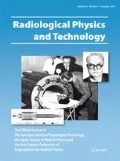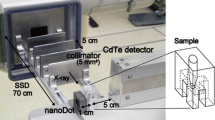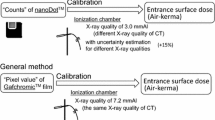Abstract
Our aim in this study is to derive an identification limit on a dosimeter for not disturbing a medical image when patients wear a small-type optically stimulated luminescence (OSL) dosimeter on their bodies during X-ray diagnostic imaging. For evaluation of the detection limit based on an analysis of X-ray spectra, we propose a new quantitative identification method. We performed experiments for which we used diagnostic X-ray equipment, a soft-tissue-equivalent phantom (1–20 cm), and a CdTe X-ray spectrometer assuming one pixel of the X-ray imaging detector. Then, with the following two experimental settings, corresponding X-ray spectra were measured with 40–120 kVp and 0.5–1000 mAs at a source-to-detector distance of 100 cm: (1) X-rays penetrating a soft-tissue-equivalent phantom with the OSL dosimeter attached directly on the phantom, and (2) X-rays penetrating only the soft-tissue-equivalent phantom. Next, the energy fluence and errors in the fluence were calculated from the spectra. When the energy fluence with errors concerning these two experimental conditions was estimated to be indistinctive, we defined the condition as the OSL dosimeter not being identified on the X-ray image. Based on our analysis, we determined the identification limit of the dosimeter. We then compared our results with those for the general irradiation conditions used in clinics. We found that the OSL dosimeter could not be identified under the irradiation conditions of abdominal and chest radiography, namely, one can apply the OSL dosimeter to measurement of the exposure dose in the irradiation field of X-rays without disturbing medical images.




Similar content being viewed by others
References
Amy Berrington de Gonzalez and Sarah Darby. Risk of cancer from diagnostic X-ray: estimates for the UK and 14 other countries. The Lancet. 2004;363:345–51. doi:10.1016/S0140-6736(04)15433-0.
Uffmann M, Prokop CS. Digital radiography: the balance between image quality and required radiation dose. Eur J Radiol. 2009;72:202–8. doi:10.1016/j.ejrad.2009.05.060.
Komiya I, Shirasaka T, Umezu Y, et al. Patient dose measurement with fluorescent glass dosimeter: characteristics evaluation and patient skin dose measurement in abdominal interventional radiology. Jpn J Radiol Technol. 2003;60(2):270–7.
Shortt CP, Malone L, Thornton J, et al. Radiation protection to the eye and thyroid suring diagnostic cerebral angiogralhy: a phantom study. J. Med. Imaging Radiat Oncol. 2008;52:365–9. doi:10.1111/j.1440-1673.2008.01970.x.
Matsunaga Y, Kawaguchi A, Kobayashi K, et al. Dose Estimation for Exposure Conditions of Diagnostic Radiology Acquired by a 2011 Questionnaire in a Phantom Study. Jpn J Radiol Technol. 2013;69(12):1372–8. doi:10.6009/jjrt.2013_JSRT_69.12.1372.
Jursinic PA. Characterization of optically stimulated luminescent dosimeters, OSLDs, for clinical dosimetric measurements. Med Phys. 2007;34(12):4594–604. doi:10.1118/1.2804555.
Reft CS. The energy dependence and dose response of a commercial optically stimulated luminescent detector for kilovoltage photon, megavoltage photon, and electron, proton, and carbon beams. Med Phys. 2009;36(5):1690–9. doi:10.1118/1.3097283.
Lehmann J, Dunn L, Lye JE, et al. Angular dependence of the response of the nanoDot OSLD system for measurements at depth in clinical megavoltage beams, Med. Phys. 2014;41(6):061712-1-9. doi:10.1118/1.4875698.
Kerns JR, Kry SF, Sahoo N, et al. Angular dependence of the nanoDot OSL dosimeter. Med Phys. 2011;38(7):3955–62. doi:10.1118/1.3596533.
Takegami K, Hayashi H, Okino H, et al. Practical calibration curve of small-type optically stimulated luminescence (OSL) dosimeter for evaluation of entrance-skin dose in the diagnostic X-ray. Radiol Phys Technol. 2015;8:286–94. doi:10.1007/s12194-015-0318-1.
Takegami K, Hayashi H, Nakagawa K, et al. Measurement method of an exposed dose using the nanoDot dosimeter. Eur. Sor. Radiol. (EPOS). 2015;. doi:10.1594/ecr2015/C-0218.
Hayashi H, Takegami K, Okino H, et al. Procedure to measure angular dependences of personal dosimeters by means of diagnostic X-ray equipment. Med Imaging Inf Sci. 2015;32(1):8–14. doi:10.11318/mii.32.8.
Okazaki T, Hayashi H, Takegami K, et al. Evaluation of angular dependence of nanoDot OSL dosimeters toward direct measurement of entrance skin dose. Eur Soc Radiol (EPOS). 2015;. doi:10.1594/ecr2015/C-0721.
Takegami K, Hayashi H, Okino H, et al. Energy dependence measurement of small-type optically stimulated luminescence (OSL) dosimeter by means of characteristic X-rays induced with general diagnostic X-ray equipment. Radiol Phys Technol. 2015;9(1):99–108. doi:10.1007/s12194-015-0339-9.
Nakagawa N, Hayashi H, Okino H, et al. Fabrication of Annealing Equipment for Optically Stimulated Luminescence (OSL) Dosimeter. Jpn J. Radiol Technol. 2014;70(10):1135–42. doi:10.6009/jjrt.2014_JSRT_70.10.1135.
Hayashi H, Nakagawa K, Okino H, et al. High accuracy measurements by consecutive readings of OSL dosimeter. Med Imaging Inf Sci. 2014;31(2):28–34. doi:10.11318/mii.31.28.
Maehata I, Hayashi H, Kimoto N. Practical method for determination of air-kerma by using an ionization chamber toward the construction of secondary X-ray field to be used in clinical examination rooms. Radiol Phys Tech. 2016. doi:10.1007/s12194-016-0352-7.
Debertin K, Schötzig U. Limitations of the pulser method for pile-up corrections in Ge(Li)-spectrometry. Nucl Instrum Meth. 1977;140(2):337–40. doi:10.1016/0029-554X(77)90302-0.
Then SS, Geurink FDP, Bode P. A pulse generator simulating Ge-detector signals for dead-time and pile-up correction in gamma-ray spectrometry in INAA without distortion of the detector spectrum. J Radioanal Nucl Chem. 1997;215(2):249–52. doi:10.1007/BF02034473.
Cano-Ott D, Tain JL, Gadea A. Pulse pileup correction of large NaI(Tl) total absorption spectra using the true pulse shape. Nucl Instrum Meth. 1999;430:488–97. doi:10.1016/S0168-9002(99)00216-8.
Hirayama H, Namito Y, Bielajew AF, et al. The EGS5 code system, SLAC Report number: SLAC-R-730, KEK Report number: 2005-8.
Okino H, Hayashi H, Nakagawa K, et al. Measurement of Response Function of CdTe Detector Using Diagnostic X-ray Equipment and Evaluation of Monte Carlo Simulation Code. Jpn J Radiol Technol. 2014;70(12):1381–91. doi:10.6009/jjrt.2014_JSRT_70.12.1381.
Knoll GF. Radiation Detection and Measurement. New York: Willy; 2000.
Fukuda I, Hayashi H, Takegami K, et al. Development of an experimental apparatus for energy calibration of a cdte detector by means of diagnostic X-ray equipment. Jpn J Radiol Technol. 2013;69(9):952–9. doi:10.6009/jjrt.2013_JSRT_69.9.952.
Asada Y, Suzuki S, Kobayashi K, et al. Summary of results of the patient exposures in diagnostic radiography in 2011 questionnaire -focus on radiographic conditions-. Jpn J Radiol Technol. 2012;69(9):1261–8. doi:10.6009/jjrt.2012_JSRT_68.9.1261.
Acknowledgments
This work was supported by JSPS KAKENHI Grant Number 15K19205.
Author information
Authors and Affiliations
Corresponding author
Ethics declarations
Conflict of interest
T. Okazaki, T. Hashizume, and I. Kobayashi are employees of Nagase Landauer Ltd. and are collaborative researchers.
About this article
Cite this article
Takegami, K., Hayashi, H., Okino, H. et al. Estimation of identification limit for a small-type OSL dosimeter on the medical images by measurement of X-ray spectra. Radiol Phys Technol 9, 286–292 (2016). https://doi.org/10.1007/s12194-016-0362-5
Received:
Revised:
Accepted:
Published:
Issue Date:
DOI: https://doi.org/10.1007/s12194-016-0362-5




